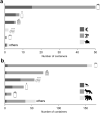Online media reveals a global problem of discarded containers as deadly traps for animals
- PMID: 33431925
- PMCID: PMC7801720
- DOI: 10.1038/s41598-020-79549-8
Online media reveals a global problem of discarded containers as deadly traps for animals
Abstract
The widespread occurrence of litter is a severe threat to global ecosystems. We have analyzed online media, to assess the diversity of animals that are prone to getting trapped in discarded containers and check which kind of containers is the most common trap for animals. A total of 503 records from around the world (51 countries, 6 continents) have been found. These include invertebrates (17 taxa, ca.1050 dead individuals), and vertebrates (98 taxa, 496 individuals including 44 carcasses). The latter group was most frequently represented by mammals (78.5% of all cases), then reptiles (15.3%), birds (1.2%), fish (1.0%) and amphibians (0.4%). Nearly 12.5% of the determined vertebrates are classified as vulnerable, endangered or critically endangered, according to the IUCN. Although most trapped individuals were smaller animals, bigger ones such as monitor lizards (Varanus spp.) or large carnivores were also recorded. In most cases, animals were trapped in glass or plastic jars (32.4%), drink cans (16.5%), and steel cans (16.3%). Our results demonstrate that discarded containers can be a threat to all major groups of animals. In order to address this phenomenon, it is necessary to decrease a global production of debris, implement container deposit legislation and organize repeatable cleanup actions.
Conflict of interest statement
The authors declare no competing interests.
Figures





References
-
- Kaza, S., Yao, L., Bhada-Tata, P. & Van Woerden, F. What a waste 2.0: A global snapshot of solid waste management to 2050. Urban Development (World Bank, Washington, DC, 2018).
-
- Obradović M, Kalambura S, Smolec D, Jovičić N. Dumping and illegal transport of hazardous waste, danger of modern society. Coll. Antropol. 2014;38:793–803. - PubMed
-
- Kubásek M, Hřebíček J. Crowdsource approach for mapping of illegal dumps in the Czech Republic. Int. J. Spatial Data Infrastruct. Res. 2013;8:144–157.
Publication types
MeSH terms
Substances
LinkOut - more resources
Full Text Sources
Other Literature Sources
Miscellaneous

